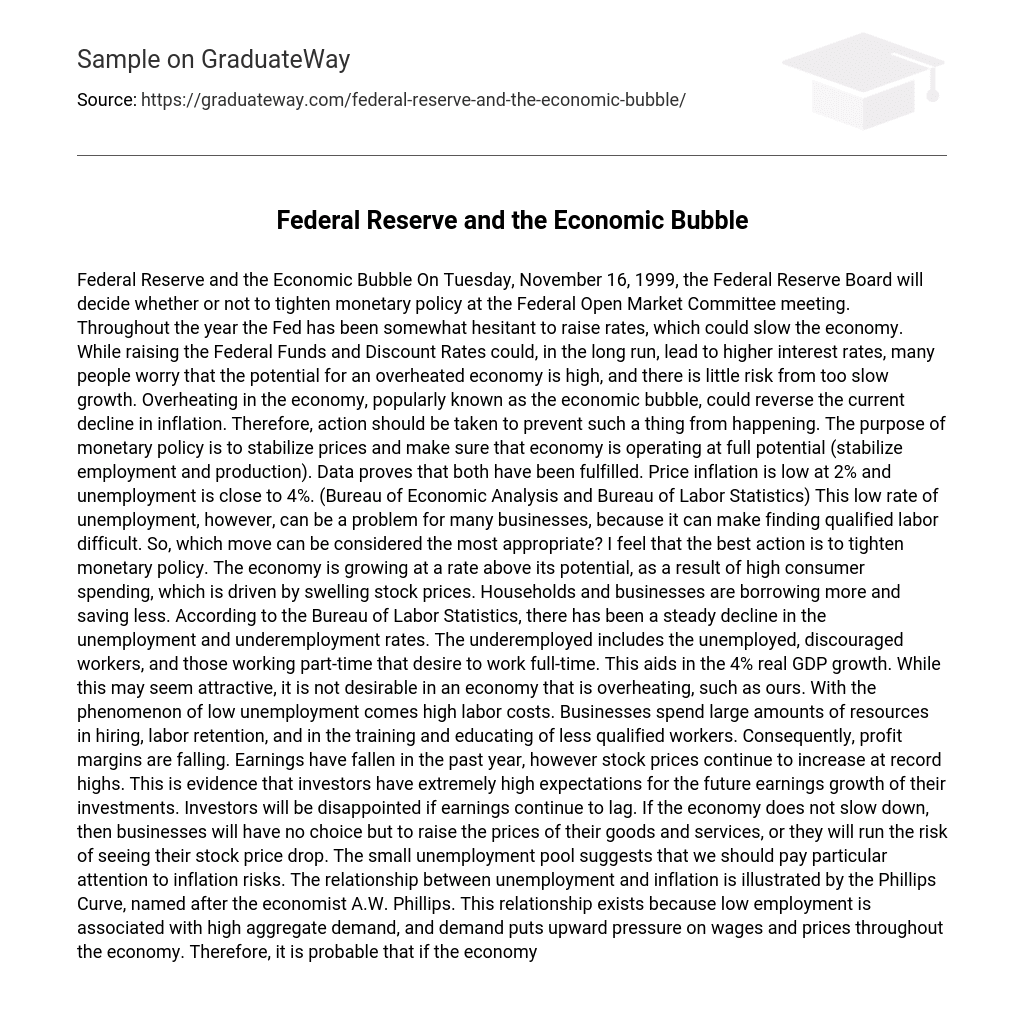Federal Reserve and the Economic Bubble On Tuesday, November 16, 1999, the Federal Reserve Board will decide whether or not to tighten monetary policy at the Federal Open Market Committee meeting. Throughout the year the Fed has been somewhat hesitant to raise rates, which could slow the economy. While raising the Federal Funds and Discount Rates could, in the long run, lead to higher interest rates, many people worry that the potential for an overheated economy is high, and there is little risk from too slow growth. Overheating in the economy, popularly known as the economic bubble, could reverse the current decline in inflation.
Therefore, action should be taken to prevent such a thing from happening. The purpose of monetary policy is to stabilize prices and make sure that economy is operating at full potential (stabilize employment and production). Data proves that both have been fulfilled. Price inflation is low at 2% and unemployment is close to 4%. (Bureau of Economic Analysis and Bureau of Labor Statistics) This low rate of unemployment, however, can be a problem for many businesses, because it can make finding qualified labor difficult.
So, which move can be considered the most appropriate? I feel that the best action is to tighten monetary policy. The economy is growing at a rate above its potential, as a result of high consumer spending, which is driven by swelling stock prices. Households and businesses are borrowing more and saving less. According to the Bureau of Labor Statistics, there has been a steady decline in the unemployment and underemployment rates.
The underemployed includes the unemployed, discouraged workers, and those working part-time that desire to work full-time. This aids in the 4% real GDP growth. While this may seem attractive, it is not desirable in an economy that is overheating, such as ours. With the phenomenon of low unemployment comes high labor costs. Businesses spend large amounts of resources in hiring, labor retention, and in the training and educating of less qualified workers. Consequently, profit margins are falling.
Earnings have fallen in the past year, however stock prices continue to increase at record highs. This is evidence that investors have extremely high expectations for the future earnings growth of their investments. Investors will be disappointed if earnings continue to lag. If the economy does not slow down, then businesses will have no choice but to raise the prices of their goods and services, or they will run the risk of seeing their stock price drop.
The small unemployment pool suggests that we should pay particular attention to inflation risks. The relationship between unemployment and inflation is illustrated by the Phillips Curve, named after the economist A.W. Phillips. This relationship exists because low employment is associated with high aggregate demand, and demand puts upward pressure on wages and prices throughout the economy. Therefore, it is probable that if the economy remains overheated, then inflation will rise.
The model of the Philips Curve is also related to the Model of Aggregate Demand and Aggregate Supply. This model shows the relationship between the price level and the quantity of output of goods and services. The higher the aggregate demand, the greater the output, and in turn, the lower the unemployment rate. The lower the aggregate demand, the lower the supply, and the higher the unemployment rate. A decrease in the money supply, which can be accomplished by raising rates, will shift the aggregate demand curve to the left and move the economy to a point with low inflation and higher unemployment. This will not only keep the economy away from possible inflation, but it will also provide companies with a larger and more qualified applicant pool.
Raising the Federal Funds Rate (interest rate that banks charge each other) and the Discount Rate (interest on the loans that the Fed makes to banks) will decrease the demand by banks to borrow from the Fed. This leads to the reduction in the money supply. If the money supply within banks is reduced, then banks will raise their interest rates, which will discourage the non-bank public from borrowing, and encourage them to save. This in turn will reduce consumer spending. Inflation is at a very low point, and many economists, such as Alan Greenspan, are doubtful that it will get any lower.
However, additional rate hikes might prevent the excessive overheating that many economists fear. The Federal Reserve Board made the decision to tighten monetary policy on November 16, 1999. The federal funds rate was raised 25 base points to 5.5%. The discount rate was raised 25 base points from 4.75% to 5%. Works Cited “Trapped by the Bubble The Economist 25 Sept. 1999: 17 18.
Boldin, Michael. Foreseeing Rate Hikes in the Futures Market www.dismal.com Boldin, Michael. What Will the Fed Do Next? www.dismal.com Glassman, James K., Kevin A. Hasset “Dow 36000” The Atlantic Monthly Sept 1999: 37-58. Kohn, Donald L.
Secretary of the FOMC Minutes of the Federal Open Market Committee www.dismal.com/fed/minutes/fomc_minutes082499.stm Schlesinger, Jacob M. Fed Holds Rates Steady but Chills Market. Wall Street Journal 6 Oct. 1999, A2 Schlesinger, Jacob M. “Stock Surge Could Trigger Fed Move. Wall Street Journal 8 Oct.
1999, A2. Schlesinger, Jacob M. and Sarah Lueck Fed Raises Rates by One-Quarter Point. Wall Street Journal 17 Nov. 1999, A2 Testimony of Alan Greenspan; July 22, 1999; http://woodrow.mpls.frb.fed.us/info/policy/mpo/mp9997.html July 1999 Humphrey-Hawkins Report: Report Section 1: Monetary Policy and the Economic Outlook http://www.bog.frb.fed.us/boarddocs/HH/1999/July/Reportsection1.htm Economy At a Glance; Bureau of Labor Statistics; http://stats.bls.gov/eag.table.htmlBibliography:





